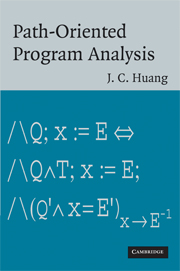Book contents
- Frontmatter
- Contents
- Preface
- 1 Introduction
- 2 State constraints
- 3 Subprogram simplification
- 4 Program set
- 5 Pathwise decomposition
- 6 Tautological constraints
- 7 Program recomposition
- 8 Discussion
- 9 Automatic generation of symbolic traces
- Appendix A Examples
- Appendix B Logico-mathematical background
- References
- Index
Preface
Published online by Cambridge University Press: 03 September 2009
- Frontmatter
- Contents
- Preface
- 1 Introduction
- 2 State constraints
- 3 Subprogram simplification
- 4 Program set
- 5 Pathwise decomposition
- 6 Tautological constraints
- 7 Program recomposition
- 8 Discussion
- 9 Automatic generation of symbolic traces
- Appendix A Examples
- Appendix B Logico-mathematical background
- References
- Index
Summary
Many years ago, I was given the responsibility of leading a large software project. The aspect of the project that worried me the most was the correctness of the programs produced. Whenever a part of the product became suspect, I could not put my mind to rest until the product was tested successfully with a well-chosen set of test cases and until I was able to understand the source code in question clearly and completely. It was not always easy to understand. That was when I started to search for ways to facilitate program understanding.
A program can be difficult to understand for many reasons. The difficulty may stem, for example, from the reader's unfamiliarity with the application area, from the obscurity of the algorithm implemented, or from the complex logic used in organizing the source code. Given the different reasons that difficulty may arise, a single comprehensive solution to this problem may never be found.
I realized, however, that the creator of a program must always decompose the task to be performed by the program to the extent that it can be prescribed in terms of the programming language used. If the reader could see exactly how the task was decomposed, the difficulty of understanding the code would be eased because the reader could separately process each subprogram, which would be smaller in size and complexity than the program as a whole.
- Type
- Chapter
- Information
- Path-Oriented Program Analysis , pp. ix - xiiPublisher: Cambridge University PressPrint publication year: 2007

